By Paramveer Bhangu, Sanjeet Singh, Catarina Brasil, Ziya Ziya, Kyle Moll Lee, and Raemond Prum
Succulence
In the desert water is not readily available, a lot of it is underground. Due to the lack of rain and the climate of the desert, plants have adapted to be able to retain a lot of water. This enables them to survive the harsh desert conditions.
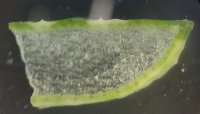
Succulents contain parenchyma cells that are specialized as water storage tissues (Sajeva and Mauseth, 1991). In a way, these parenchyma cells act as a water reservoir for succulent plants. Succulents also contain mucilage cells which are thick and gluey and they aid in water retention. They provide a slimy texture to the leaves when cut. All of this allows succulent leaves not only to absorb water but also retain water. A succulent to focus on is the Aloe vera plant as they are able to retain water in their leaves amidst the harsh weather climate. Aloe vera has a very thick epidermis that is important for water retention as it prevents excessive transpiration. On the inside you have vascular bundles that consist of tubular structures that are very important for stems and other structures. Stems play an important role in not only providing structure and support for the plant but this also allows for water and nutrients to be moved through the plant.
Another example would be the cactus genus Opuntia. This cactus is composed fleshy stemscalled cladodes that readily grow on top of each other, which are loaded with spines found in the areoles. These cladodes readily root to form new plants frequently which makes them a very successful invasive species. They are also very salt tolerant and resistant to any damage that may be posed by animals which further helps them in protection.
Desert plants must protect themselves in order to survive and not be eaten by animals. Some defend themselves with physical defenses such as spines, while other defend themselves with toxic chemicals.
Physical Defenses
Many succulent species do not possess true branches or leaves. Instead, these sharp succulents hold highly modified branches known as areoles. These structures are where the infamous sharp spines grow from. Thus, the spines are the highly modified leaves whereas the areoles are the highly modified branches (Cacti only). Correspondingly, some cacti species appear to have hair and are extremely fuzzy. This “hair”, also called glochids, are found on the radial spines where their main function is to protect the plant from both frost and sun. The hairs we see are modified spines! However, the real question is, why would these succulents get rid of the true leaves to grow spikes? (Lita, 2021)
Succulent stems are actually able to undergo photosynthesis, and leaves aren’t needed as succulents tend to grow in areas with a lot of sunlight. Second, succulent spines reduce water loss. The spines do this by breaking up air flow, reducing evaporation, and creating a buffer zone with moist air created due to the trapped air around the cactus. Third, spines are able to collect dew in moist or foggy morning situations. The dew will then be dropped by the spines which allows the roots to absorb the water. This is done via the “special grooves” that aid the spines in collecting a significant amount of water. Fun fact: There is current research being done to replicate these specialized grooves for improved water collection in arid climates. Lastly, spines protect the plant from predators who love tearing the cacti apart and sucking on the tissues that aid in water storage. (Fratt, 2019)
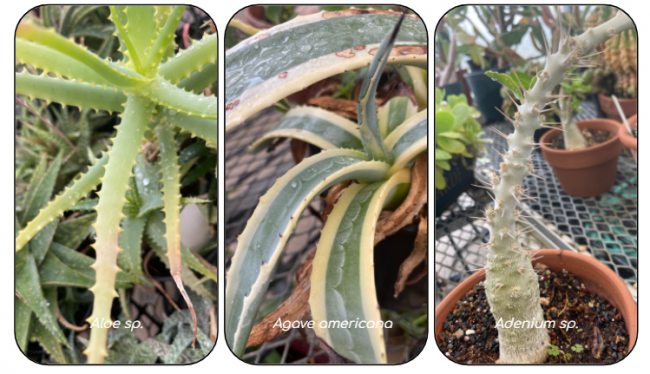
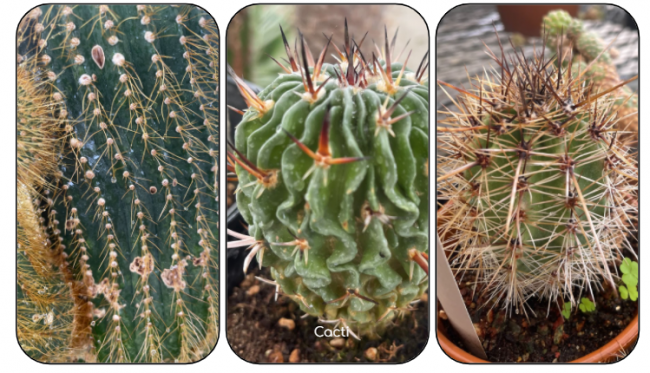
Chemical Defenses
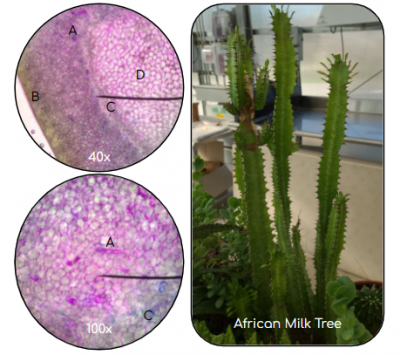
Besides physical defense mechanisms, plants also have a secondary line of defense that falls under chemical defense protection. Physical defense mechanisms include structures such as spines whereas chemical defense includes latex. There are two families that are primarily focused on for their defensive chemical components which include Family Apocynaceae and Euphorbiaceae.
The African Milk Tree (Euphorbia trigona, Euphorbiacae). We made stained slides of a cross section of a shoot. The dark purple structures are the latex-producing laticifers. When cut or squeezed, toxic latex will come out of these structures. They grow in tropical dry forests and deciduous forests.
Upper left: 40X magnification a) laticiers b) epidermis c) cambium d) pith
Lower left: 100X magnification a) laticifers c) cambium
Q: What is latex and how is it produced?
A: Latex is a milk-like fluid that is secreted after plant tissues have been destroyed or damaged. It is stored in laticifer cells which are responsible for the production of latex. (Salomé Abarca et al., 2019)
Q: How does latex produced from plants serve as a line of defense?
A: The latex produced from plants can provide defensive protection against insect herbivores and pathogens. The latex is sticky and can glue the mouthparts and hinder the movement of herbivores while also disabling their sensory organs. Chemically, the latex is composed of a variety of proteins and specialized products such as terpenoids and alkaloids which serve to be toxic against insects and pathogenic microorganisms. (Hua et al., 2017)
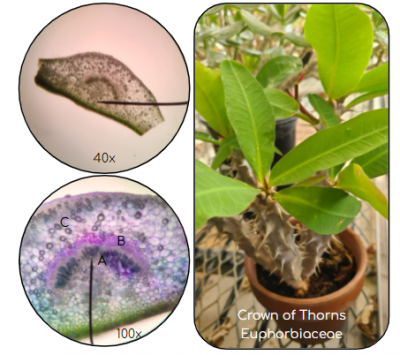
Euphorbia milii, the Crown of Thorns, is native to Madagascar. This plant contains latex in its leaves and stems which can cause irritation to humans and other animals. There also appears to be bubbles on both magnifications. We believe these are latex remnants when we made the slide. Under these “bubbles” are parenchyma-like cells that are metabolically active.
Upper Left: 40X Magnification of leaf petiole
Lower Left: 100X Magnification A) Xylem B) Phloem C) Parenchyma-like cells
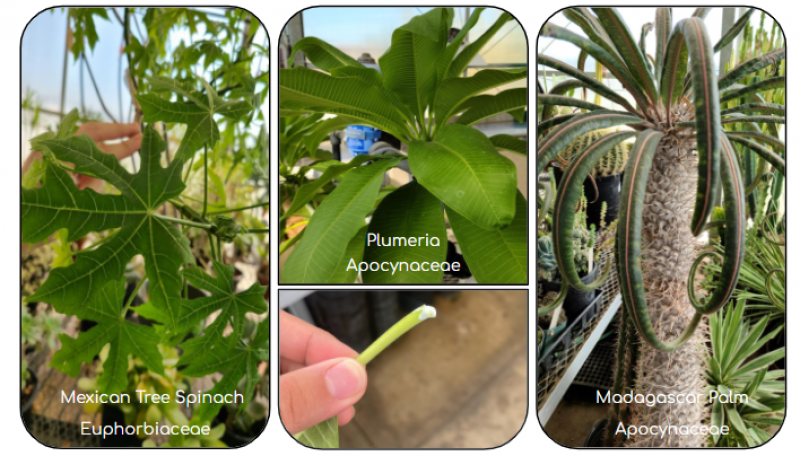
One more Euphorbiaceae (left) and two Apocynaceae (right). The bottom right is the Madagascar palm and it produces a clear latex, whereas other succulents produce white latex.
References:
- Fratt, K. (2019). Why do cacti have spines? 4 reasons cacti are spikey. Plantsnap. Retrieved December 8, 2021, from https://www.plantsnap.com/blog/why-do-cacti-have-spines-4-reasons-cacti-...
- Hua, J., Liu, Y., Xiao, C.-J., Jing, S.-X., Luo, S.-H., & Li, S.-H. (2017). Chemical profile and defensive function of the latex of Euphorbia peplus. Phytochemistry, 136, 56–64. https://doi.org/10.1016/j.phytochem.2016.12.021
- Lita, G. (2021). Why is my cactus hairy? (explained). GardenSuperior. Retrieved December 8, 2021, from https://gardensuperior.com/why-is-my-cactus-hairy-explained/.
- https://plants.ces.ncsu.edu/plants/opuntia/
- Sajeva, M., and J. D. Mauseth. "Leaf-like structure in the photosynthetic, succulent stems of cacti." Annals of botany 68.5 (1991): 405-411.
- Salomé Abarca, L. F., Klinkhamer, P. G., & Choi, Y. H. (2019). Plant Latex, from ecological interests to bioactive chemical resources. Planta Medica, 85(11/12), 856–868. https://doi.org/10.1055/a-0923-8215
Updated: August 08, 2023